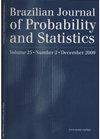基于新版Skellam INGARCH模型的z值时间序列建模
IF 0.5
4区 数学
Q4 STATISTICS & PROBABILITY
引用次数: 9
摘要
近年来,人们对整值时间序列模型越来越感兴趣,包括整值自回归(INAR)模型和整值广义自回归条件异方差(INGARCH)模型,但只有少数模型能够处理整集合上的数据,即Z ={…,−2,−1,0,1,2,…}。尽管已经进行了一些尝试来处理z值时间序列,但这些模型在建模某些特定整数(例如0,±1)时不能提供足够的灵活性。文献中提出了一种对称的Skellam INGARCH(1,1)模型,但该模型只考虑零均值过程,限制了其应用。我们首先将对称的Skellam INGARCH模型扩展到非对称的版本,该版本可以处理非零均值过程。然后,我们提出了一种改进的Skellam模型,该模型对整数0和±1进行了仔细处理,以满足数据的特殊特征。我们的模型易于使用和灵活。采用极大似然法估计未知参数,并采用对数似然比检验统计量对修正后的非对称模型进行检验。对参数估计和对数似然比检验的性能进行了仿真研究。最后给出了一个实际的数据示例,验证了所提模型的良好性能。本文章由计算机程序翻译,如有差异,请以英文原文为准。
Modeling Z-valued time series based on new versions of the Skellam INGARCH model
Recently, there has been a growing interest in integer-valued time series models, including integer-valued autoregressive (INAR) models and integer-valued generalized autoregressive conditional heteroscedastic (INGARCH) models, but only a few of them can deal with data on the full set of integers, i.e., Z = {...,−2,−1, 0, 1, 2, ...}. Although some attempts have been made to deal with Z-valued time series, these models do not provide enough flexibility in modeling some specific integers (e.g. 0, ±1). A symmetric Skellam INGARCH(1,1) model was proposed in the literature, but it only considered zero-mean processes, which limits its application. We first extend the symmetric Skellam INGARCH model to an asymmetric version, which can deal with non-zero-mean processes. Then we propose a modified Skellam model which adopts a careful treatment on integers 0 and ±1 to satisfy a special feature of the data. Our models are easy-to-use and flexible. The maximum likelihood method is used to estimate unknown parameters and the log-likelihood ratio test statistic is provided for testing the asymmetric model against the modified one. Simulation studies are given to evaluate performances of the parametric estimation and log-likelihood ratio test. A real data example is also presented to demonstrate good performances of newly proposed models.
求助全文
通过发布文献求助,成功后即可免费获取论文全文。
去求助
来源期刊

Brazilian Journal of Probability and Statistics
STATISTICS & PROBABILITY-
CiteScore
1.60
自引率
10.00%
发文量
30
审稿时长
>12 weeks
期刊介绍:
The Brazilian Journal of Probability and Statistics aims to publish high quality research papers in applied probability, applied statistics, computational statistics, mathematical statistics, probability theory and stochastic processes.
More specifically, the following types of contributions will be considered:
(i) Original articles dealing with methodological developments, comparison of competing techniques or their computational aspects.
(ii) Original articles developing theoretical results.
(iii) Articles that contain novel applications of existing methodologies to practical problems. For these papers the focus is in the importance and originality of the applied problem, as well as, applications of the best available methodologies to solve it.
(iv) Survey articles containing a thorough coverage of topics of broad interest to probability and statistics. The journal will occasionally publish book reviews, invited papers and essays on the teaching of statistics.
 求助内容:
求助内容: 应助结果提醒方式:
应助结果提醒方式:


